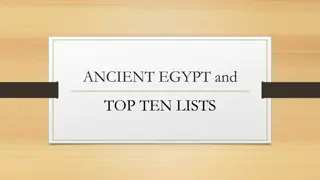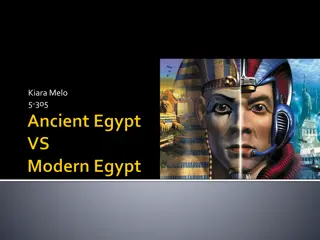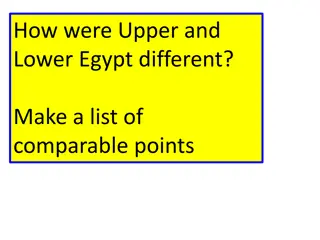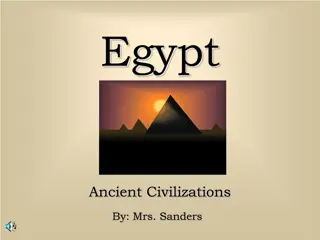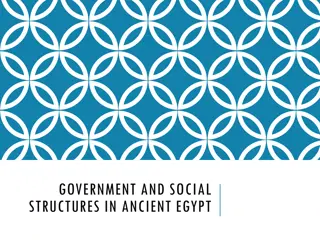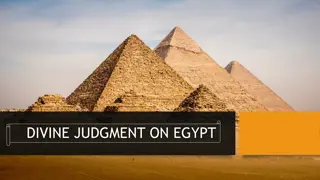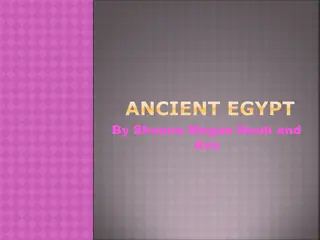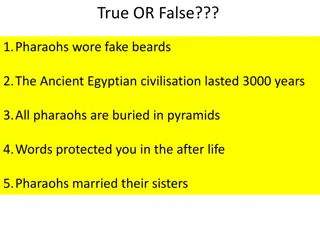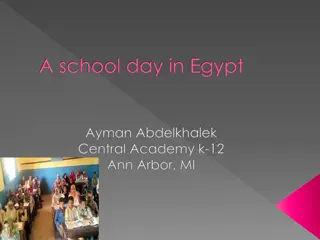Pharaoh Ramses II: Military Leader and Master Builder in Ancient Egypt
Pharaoh Ramses II, known as Ramses the Great, ruled Ancient Egypt for over 60 years during the New Kingdom period. He was a fearless military leader, signing the world's first peace treaty with the Hittites. Ramses was also a prolific builder, known for monuments like the temple complex at Abu Simbel. His legacy includes giant statues and impeccably preserved mummy, showcasing his enduring impact on Egyptian history.
Download Presentation

Please find below an Image/Link to download the presentation.
The content on the website is provided AS IS for your information and personal use only. It may not be sold, licensed, or shared on other websites without obtaining consent from the author. Download presentation by click this link. If you encounter any issues during the download, it is possible that the publisher has removed the file from their server.
E N D
Presentation Transcript
ANCIENT EGYPT and Nonfiction Summary
Social Studies Chapter 8, Section 6 Pharaoh Ramses II: Military Leader and Master Builder The pharaoh Ramses II (RAM-seez) ruled from about 1290 to 1224 B.C.E., during the New Kingdom. Called Ramses the Great, he is one of the most famous pharaohs. He reigned for more than 60 years, longer than almost any other pharaoh. He is best known for his military leadership and for building numerous monuments. Ramses used his power to excess. He had over 100 wives, and more than 100 children. Never shy about his importance, he had hundreds of statues of himself erected throughout Egypt. Some of them were over 60 feet high. From a young age, Ramses was a fearless soldier. He fought alongside his father in various battles. At the age of ten, Ramses was made a captain in the Egyptian army. Ramses tried to defend an Egyptian empire that extended north into Canaan. His most famous military campaigns were against the Hittite Empire in Anatolia (present-day Turkey). The Hittites constantly threatened Egypt's northern borders. In his best-known battle, Ramses reached a standoff with the Hittites, even though he was greatly outnumbered. Ramses was also a peacemaker. He and the Hittites signed the world's first peace treaty. This peace lasted until the Hittite Empire collapsed around 1190 B.C.E. One of Ramses' greatest projects was the temple complex at Abu Simbel. The main temple was carved into the side of a cliff. The cliff was on a bank of the Nile River. A smaller temple honored his favorite wife, Nefertari. Four giant statues of a seated Ramses framed the entrance to the main temple. The figures were carved right out of the rock face of the cliff. They are among the finest examples of the artistic skill of Egyptian sculptors. The inside of the temple was also remarkable. Visitors passed through three large rooms, called halls, to reach the temple's main room. This room's altar contained statues of Ramses and three Egyptian gods. The temple was built so that, twice a year, the sun lined up with the entrance. Beams of sunlight would shine down the halls and light up the statues. Ramses ordered more temples and monuments built than any other pharaoh in history. When he died, he was buried in the tomb that he had ordered workers to construct solely for him. His mummy is one of the best-preserved bodies ever found. MAIN IDEA: Ramses II is one of Ancient Egypt s most famous pharaohs. Ruled from about 1290 to 1224 BC.E., during the New Kingdom. He was a pharaoh for more than 60 years, more than any other pharaoh Most known for military leadership and building monuments He was a fearless leader, becoming a captain in an Egyptian army at age 10 Ramses and the Hittites signed the first peace treaty. Ramses was a peacemaker. He created the temple complex at Abu Simbel, had giant statues created (some of himself) The inside of the temple had several rooms, statues, which are known as remarkable When Ramses died, his body was buried in a tomb only for him one of the best-preserved bodies ever found
Social Studies Chapter 8, Section 6 Pharaoh Ramses II: Military Leader and Master Builder
Social Studies Chapter 8, Section 6 Pharaoh Ramses II: Military Leader and Master Builder Ramses II is one of the most known pharaohs from Ancient Egypt. Ramses II reigned from 1290 to 1224 BCE, during the New Kingdom. His reign was the longest of any pharaoh, lasting sixty years. Ramses II is most known for his military leadership, which began at a young age. At the age of ten, Ramses II was made captain of an Egyptian army. With this background, Ramses used his skills for not only war, but for peacemaking. In fact, Ramses II and the Hittites signed the first peace treaty, ever. In addition to his military skills, Ramses is known for the hundreds of statues and monuments built, many which were of him. He created the temple complex at Abu Simbel as well as had several remarkable rooms and statues made inside the temple. When he died, Ramses was buried in a tomb made just for him, which helped to preserve his body. Ramses II was an important Pharaoh in Ancient Egypt because of his military leadership, and the monuments he had built, which are pieces of history today.
Directions for Independent Activity You will be writing a non-fiction summary for the Where did King Tut Get His Eyebrows? article Go to the Reading section of your class OneNote You will be using the Where did King Tut Get His Eyebrows? article that you have read for the past two days Review the main ideas and details that you wrote from this article on Tuesday Using the non-fiction summary organizer you created yesterday, Wednesday, you will write a final summary. The summary should be 8-10 sentences long and include the main idea, support details, and closing sentence. Re-read your summary to check for correct, spelling, capitalization, punctuation, and sentence formation This work is mandatory and must be submitted for a grade If you do this on OneNote that counts as submitting work because your teacher will be able to see it there. If not, you need to email your completed summary to your teacher
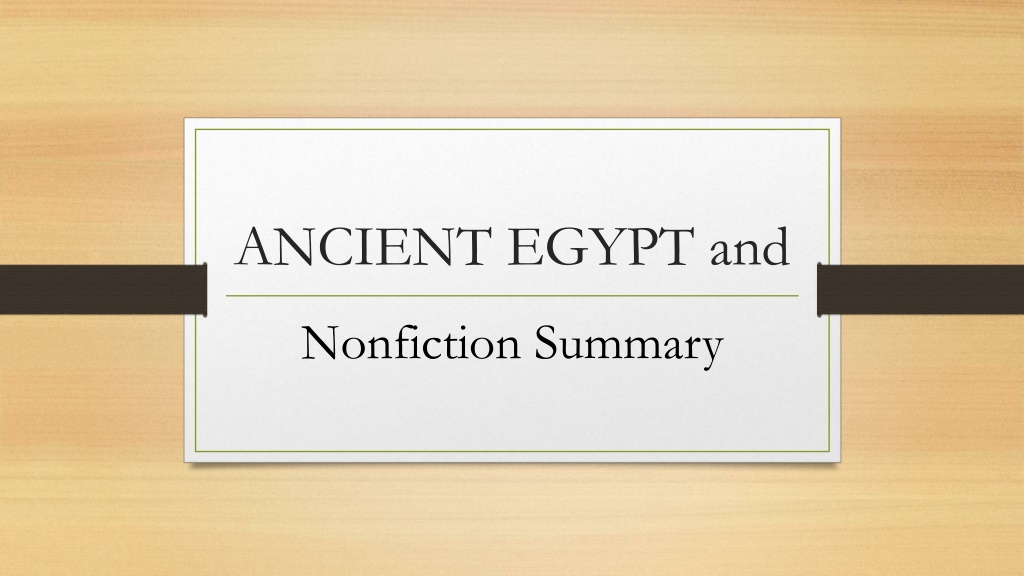

![[PDF⚡READ❤ONLINE] Tutankhamun's Trumpet: Ancient Egypt in 100 Objects from the](/thumb/20549/pdf-read-online-tutankhamun-s-trumpet-ancient-egypt-in-100-objects-from-the.jpg)



